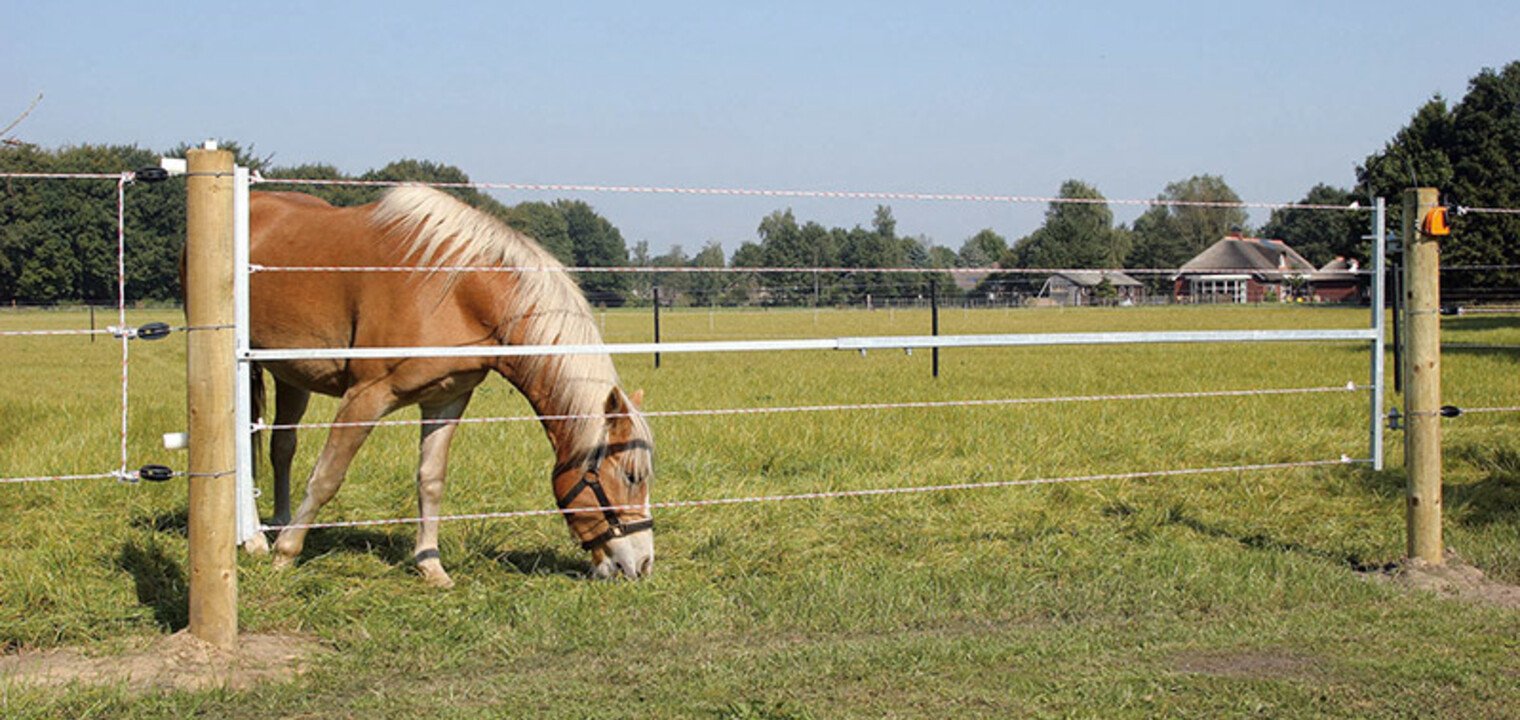Simple steps for building an electric fence for horses:
- Plan and organise what you need for your fencing
- Install your fence posts
- Attach insulators to the posts (if necessary)
- Attach the conductor (rope or tape)
- Remove the slack from the rope
- Install spring-loaded gate-breakers
- Earthing
- Charging
Plan and organise what you need for your fencing
The first step is to decide on your fencing system, whether that be permanent or temporary. This will shape the equipment that you use.
You will need:
- Posts
- Insulators
- Tape or rope to act as a conductor
- A sledgehammer or post driver
- An energiser and power source
- Grounding rods – a minimum of 1 x 1m grounding rod per 1000m fencing (or 500m for a two-strand fence)
- Tensioners
- Gate breaker kit
- Fence tester/voltmeter
The fence posts
|
Electric fence stakes form a basic structure for your fencing system, but there are four key options available. If you are considering building a temporary fencing system then plastic or fibre-glass posts will be the perfect option as they are easy to move and cost-effective. However, wooden or metal fence posts are extremely popular options if you’re looking to build a permanent fencing system. Particularly in the case of wooden fence posts, you can rest assured that providing you utilise high-quality wooden posts and construct accordingly, then your fencing will be fit for the British climate throughout the year. Top Tip - Keep them spaced at regular intervals of between 8 and 16 feet, if your area gets high winds then keep them no more than 12 feet apart. |
 |
The Conductor
When it comes to choosing the correct conductor as you consider how to build an electric fence for your horses, it is always worthwhile considering what your horses are like out in the field. If you have horses that are more prone to escape, then a thicker conductor such as electric tape may be preferable as this can help to deter them. Likewise, for horses who are well behaved, a lightweight rope might be more suitable as they are far easier to assemble. If you are looking to move your fencing around, the rope would be much more suitable. Take a look at our range of electric fence conductors.
Top Tip – Make sure that your conductor is pulled through the end tensioner to remove the slack, but make sure it isn’t too tight and overstretched. This can present a risk of the conductor snapping! If your fence is longer than 1000 feet, use end tensioners at both ends.
The Post Insulators
|
Some types of posts will already have insulators on them, but if they don’t then you will need to find a suitable insulator to attach to your post. Choosing the right insulators will be key to ensure your electric fencing system works efficiently and your horses remain where they should be! It is absolutely vital that your insulator will work with the type of conductor you are wishing to use. For example, if you decide to use fencing tape, then ensure you purchase an insulator to match this, and likewise with wire and so forth. |
 |
Earthing
Earthing your electric fence system is extremely important to make sure that it works correctly. This is because it completes the electric circuit, without this the fence will not provide a shock. Sink your grounding rod into the ground. Remember that the depth will depend on the soil type, if the ground is dry and sandy you may need multiple grounding rods. These should be linked together with brass clamps.
Top Tip - When placing the grounding rods, you need to ensure they are not running parallel to overhead lines and are a suitable distance from water pipes and underground cables (at least 50 feet). We stock a number of different grounding items to make sure you get your grounding right.
Charging
|
Arguably one of the most important elements to your electric fencing system to ensure that your electric fence unit works effectively. There are a number of options to use when building an electric fence for your horses. In most cases, fields are away from a mains power source and that often means that battery or solar-powered energisers are most appropriate on equestrian properties. If you live rurally, then we would suggest that a solar-powered energiser would work most efficiently for you but if you’re not sure what’s right for you, there’s always the multi-power energiser option! Browse our full range of electric fence energisers. It can certainly seem like a lot to consider, but thinking carefully about the electric fence posts, conductor and charging you use in particular will really help to ensure your fencing is fit for use on your property and for your horses and ponies! |
|






